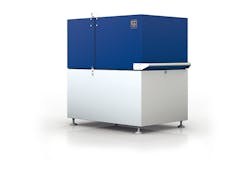Spark Spread and More From AHR
AHR never fails to produce at least one product that captivates my attention. This time, it was Lochinvar’s micro-CHP (Combined Heat & Power) XRGI 25 cogeneration system. Producing 480-volt three-phase 24-kW and capturing 163,000-Btuh from the engine exhaust renders an astounding 93% operating efficiency. One term kept being raised: Spark Spread. More on that later.
Lochinvar teamed up with EC Power, a leading producer of combined heat and power generating facilities throughout Europe, in order to develop the US co-gen market. From their brochure: Cogeneration is a game changer for the North American market as commercial facilities, such as healthcare, universities, hotels, and multi- family complexes have an increasing desire for products that provide reliable hot water with reduced energy costs. Lochinvar’s partnership with EC POWER to expand the availability of cogeneration technology will reduce operating costs for businesses and remain true to both our companies’ long-standing history of groundbreaking innovation, superior engineering and quality.
This partnership is designed to meet the growing need for reliable, alternative energy in North America. Cogeneration products decrease a facility’s environmental impact and electricity expenses by using a single heat source for domestic hot water and power generation.
There are just four main plug-and-play components: XRGI power unit; IQ25 control panel; Q70 heat distributor; and a 150-gallon thermal hot water storage tank. The XRGI power unit is driven by a Toyota 4-cylinder natural gas fired engine, which has long-term proven reliability. Designed for commercial applications with a large DHW or thermal load – like pool heating for example – the opportunity knocking for the forward-looking contractor is all around us. Hotels, factories, large office buildings connected to a factory or any place where process heating, hydronics, or other diversity of loads can ideally provide a 12- to 16-hour per day run-time.
Maintenance! First concern, from my perspective, was access to the 4-cylinder Toyota engine. Not to worry because once you pop the “hood”, the engine is almost completely exposed with free access to its oil filter and spark plugs. Noise concerns vanish too because the XRGI 25 is whisper quiet once the hood is closed at just 48- to 52-decibles (refrigerator running is rated at 5-dB).
The boost in efficiency gained by capturing waste heat and the hot water production must also be calculated and, fortunately for us contractors, the folks at Lochinvar are ready, willing, and able to assist.
You can daisy-chain multiple XRGI 25 systems together to provide 12-240-kW of electrical power and up to 1,630,000-Btuh of thermal energy. As a devout wet head that has also installed PV solar systems, dozens of potential applications back home popped into my head. ECM circulators are standard with the XRGI 25 system. If you’re not comfortable with the electric power side, hire or partner with an electrician. The hot water side is a natural fit if you’re already familiar with hydronics, radiant heating, and/or snow melting applications. If you are a plumber who provides service to hotels, hospitals, spas, gyms, colleges, or Laundromats, here’s a sweet opportunity to help your clients reduce their operating costs.
Speaking of costs, that’s where the Spark Spread comes into play. Simply stated, Spark Spread is the difference between purchase price per kW vs cost to produce kW using natural gas. Commercial power purchasers often pay a set fee for a specific amount of electrical power. Premium rates can be set for daytime consumption with penalties when the facility draws power in excess of set limits. Those penalties can add thousands of dollars in cost and set up an idea Spark Spread making the XRGI an ideal solution.
The math gets a bit complicated because you need to consider more than just the generator power production compared to the cubic feet of natural gas consumed. The boost in efficiency gained by capturing waste heat and the hot water production must also be calculated and, fortunately for us contractors, the folks at Lochinvar are ready, willing, and able to assist.
I was asked, by Mike Lahti, VP of Sales & Marketing, what I saw as the biggest challenge for contractors? Weight! Speaking strictly about the power unit, and its 1,500-Lb weight, which is obviously something we won’t be lugging up and down steps! All kidding aside, the site applications that quickly come to mind won’t have steps to deal with, typically there are fork lifts available, and freight elevators, so even though the heart of the system is hefty, I really don’t see that as a huge obstacle.
I asked Lahti the question you or I will be asked: what’s the payback and life expectancy? Three to five years, depending on the application and Spark Spread and life expectancy of eight to ten years, or more depending on operating conditions and maintenance. Think about this: five year payback and five years of money saved to essentially pay for the next XRGI 25 – pretty sweet. As we all know, the first installation is the more expensive installation with subsequent replacements requiring a fraction of the time because all the ancillary components will already be in place.
Here’s a video link to the XRGI 25 system: https://youtu.be/-FHDxLmQS88
Dave Yates material both in print and online is protected by Copyright 2018. Any reuse of this material (print or electronic) must have the express written permission of Dave Yates and CONTRACTOR magazine. Please contact via email at [email protected].
